

University of Chicago Gets $13 Million to Attract More Hispanic Students
HYDE PARK — The Neubauer Family Foundation is spending $13 million to get more Hispanic students on campus at the University of Chicago.
The foundation announced Monday it is committing $13 million to reach out to Hispanic high school students to get them into programs on campus, as well as for financial support if they enroll at the University of Chicago…
Link to announcement
Wealth inequality has widened along racial, ethnic lines since end of Great Recession
The Great Recession, fueled by the crises in the housing and financial markets, was universally hard on the net worth of American families. But even as the economic recovery has begun to mend asset prices, not all households have benefited alike, and wealth inequality has widened along racial and ethnic lines.
The wealth of white households was 13 times the median wealth of black households in 2013, compared with eight times the wealth in 2010, according to a new Pew Research Center analysis of data from the Federal Reserve’s Survey of Consumer Finances. Likewise, the wealth of white households is now more than 10 times the wealth of Hispanic households, compared with nine times the wealth in 2010…
Link to report
Mexican professionals bringing ambition, startups to North Texas
Dallas Morning News
A cocktail mixer sponsored by the Association of Mexican Entrepreneurs …. “Americans respect power, and that’s what we’re striving for, economic …
Link to article
Cafecito: Guillermo del Toro On How To Thrive In Hollywood
Guillermo del Toro, one of Hollywood’s most talented and prolific directors and producers, spoke to Cafecito host Feliciano Garcia on the challenges he faced when he first arrived in Hollywood from Mexico in the 1990s.
“When I came it it was more difficult to make the community understand that Latin talent didn’t have to be ghettoized and marginalized into exclusively Latino projects,” said del Toro. He said that as years have gone by and with directors like Alfonso Cuaron and Robert Rodriguez behind the cameras and with others in front of the cameras, “I think we have earned the right to be taken seriously on every endeavor we want to take.”…
Link to article
Slow and Steady Progress for Mexican American Professionals: The results of the American surveys for the years 2010-2012 show positive results
By Humberto Gutierrez
Edited by Kristen House
College enrollment showed an increase of 1.4 percent from 2010 to 2012—a positive sign for Mexican Americans wanting to achieve higher academic and professional goals. Here is the data.

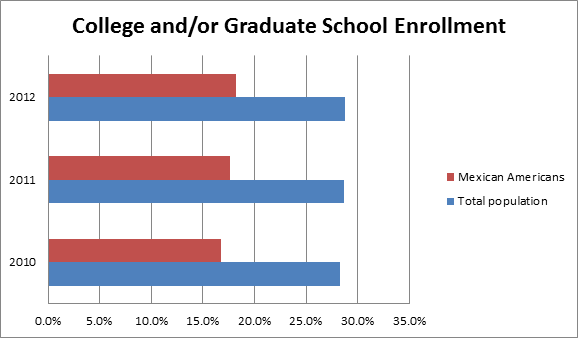
Educational attainment shows no change to the terrible numbers of 2.6 percent for the years 2010 and 2011 but there is hope in that 2012 showed a small gain to 2.9 percent.

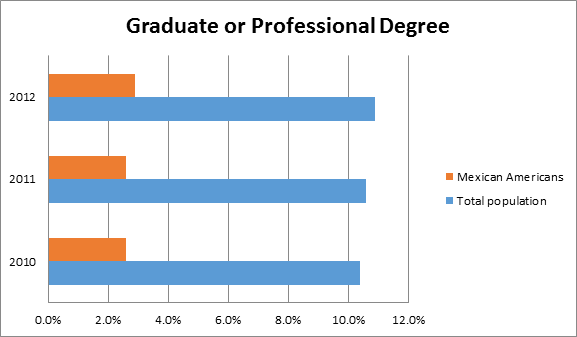
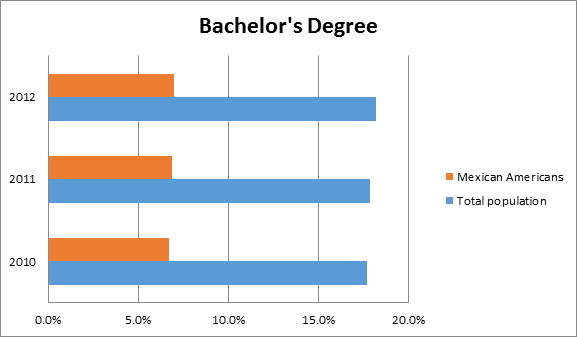
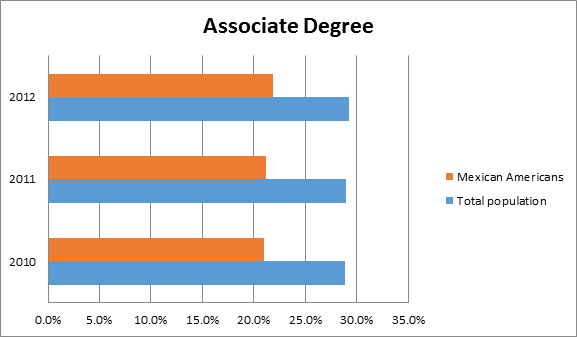
For occupations, there was a .2 percent increment yearly, but still shows that in management, business, science, and art occupations, there is still a wide gap between the total population at 36.1 percent for the year 2012 and 16.6 percent for Mexican Americans.


For professional, scientific, and management and administrative and waste management services, there is a close correlation between the percentage represented by the total population and Mexican Americans.

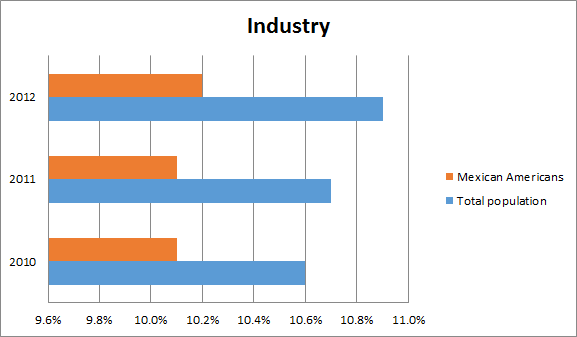
Summary:
There is hope at the end of the tunnel. College and university enrollment has been trending higher for Mexican Americans. Unfortunately, the percentage of students with graduate degrees stayed the same for the years 2010 and 2011, but rose a small amount in 2012. Percentages showing students with BA and AA degrees trended higher—an encouraging sign. Occupations still showed a wide margin between the total population and Mexican Americans. The Mexican American population showed a small increase in professional, scientific, and management and administrative and waste management employment while the total population showed a small but steady increase in this area.
References:
- Census Bureau, Selected Population Profile in the United States: 2010 – 2012
- United States S0201. Selected population Profile in the United States
- Population Group: Mexican and Total Population
- Data Set: American Community Survey 1-Year Estimates
Employment & Job News 2014: US Employers Hire 321,000 Employees in November; Latino Unemployment Drops Slightly
Employment & Job News 2014: US Employers Hire 321,000 Employees in November; Latino Unemployment Drops Slightly
U.S. employers hired 321,000 people in November, the latest sign of steady growth and health job gains. The latest job figures mean 2014 is on track to be the strongest year for hiring since 1999, and 10 million jobs were lost during the financial crisis in 2008.
More jobs, 44,000, were added in September and October than had previously been estimated. The Department of Labor said the unemployment rate remained at a six-year low of 5.8 percent.
Economy analysts say job gains will accelerate improvement in the labor market as more industries participate in the recovery. The Labor Department measured a 69.7 percent rate increase in its Diffusion index which measures industry payrolls…
Link to article
Artist, ‘cultural adjuster’ Mel Casas has died
Mel Casas, an influential artist and teacher who helped define the Chicano art movement has died after a two-year battle with cancer. He was 85.
The artist died at home Sunday surrounded by family, said Grace Casas, his wife of 35 years…
Link to article
Mexican Chef Serves Up An Authoritative Guide To Her Country’s Cuisine
If you want to give your taste buds a gustatory tour of Mexico, then Margarita Carrillo is ready to be your guide.
The Mexican chef and food activist has spent years gathering hundreds of recipes from every region of the country for Mexico: The Cookbook, her new, encyclopedic take on her country’s cuisine.
With over 700 pages and 600 recipes, the book, at first glance, can be daunting. But most of the recipes are just a paragraph long, with prep and cook times under 20 minutes. That emphasis on simplicity was a deliberate choice: Carrillo wrote her book in hopes of encouraging American home cooks to explore Mexico’s vast and varied, “labyrinthine” culinary bounty.
“Cook the simpler dishes first,” she encourages readers in her introduction, “and then challenge yourself with the more elaborate ones.”…
Link to article
Can Ethnic Studies Improve Student Achievement? Researcher Says Yes
A new study linking Mexican American Studies with academic achievement is adding to a growing national conversation about the benefits of ethnic studies curriculums, a researcher tells NBC Latino.
“In many respects, ethnic studies is sometimes treated like a convenient academic add-on,” said Nolan Cabrera, an assistant professor in the Center for the Study of Higher Education at the University of Arizona. “What this (research) is demonstrating is that ethnic studies in and of itself represents real education.” …
Link to article
A House of Mirrors: Seeing Myself, Seeing Mexican American Children
R López, C Vaughn – The Clearing House: A Journal of Educational …, 2014
Search. Advanced and citation search Within current journal Entire site. Home > List of Issues >
Latest articles > A House of Mirrors: Seeing Myself, Seeing Mexican American Children. … A House
of Mirrors: Seeing Myself, Seeing Mexican American Children. …
Link to article
What It’s Like to Be a Latino Entrepreneur in Silicon Valley
November 24, 2014 SAN JOSE, Caif.—Alex Murillo leans forward in his seat, sipping coffee from a shot glass and waving his hands as he talks. He points to the screen of his MacBook Pro, explaining the genius behind Audive, the mobile application he is developing that allows users to record cover songs and mix tracks with music enthusiasts around the world.
“This is the secret sauce,” says Murillo, hitting a key on his computer that fills the air with the sound of a man singing in Italian. “You can bring in vocals from a guy in Italy or you can bring in the flamenco guitar from Spain.”
Murillo has made this pitch about three times to potential investors in Silicon Valley since launching his start-up this summer. He came up with the idea and polished his pitch with the help of Manos Accelerator, a…
Link to article
Mexican American Women’s Reflections From Public High School
KA Taylor, SL Fernandez-Bergersen – Journal of Latinos and Education, 2014
… The oppression from double jeopardy suffered by Black women because of the intersection of
race and gender can be applied, by extension, to Mexican American woman (Collins … On
investigating the attitudes toward achievement and success of eight professional US women. …
Link to abstract
Contending with Poetry
On November 6th, Cal State LA was graced with a poetry reading by Associate Professor Ben V. Olguín of the University of Texas at San Antonio. The event titled, “Towards A Critical Masculinity: Lyrical Meditations on Gender, Race, and Violence from Houston to Havana: A Poetry Reading y Plática with B.V. Olguín,” was co-sponsored by the Department of Chicano Studies, the Programs in Women’s, Gender, and Sexuality Studies, and the Center for Contemporary Poetry and Poetics. The event took place in King Hall C4070, at 3:15 p.m. and was primarily focused on Dr. Olguín’s latest collection of poems, Red Leather Gloves (Hansen Publishing Group, 2014) Dr. Olguín began by asking his audience if anyone had ever boxed in the ring, either as an amateur or professional. Startled by such a question from an academic who was introduced as a Stanford alumnus, the audience of about ten undergraduate and graduate CSULA students remained silent…
Link to article
Mexican American Women’s Reflections From Public High School
KA Taylor, SL Fernandez-Bergersen – Journal of Latinos and Education, 2014
… The oppression from double jeopardy suffered by Black women because of the intersection of
race and gender can be applied, by extension, to Mexican American woman (Collins … On
investigating the attitudes toward achievement and success of eight professional US women. …
Link to abstract
Explaining the Mexican-American Health Paradox Using Selectivity Effects
While typically socioeconomically disadvantaged, Mexican migrants in the U.S. tend to have better health outcomes than non-Hispanic Whites. This phenomenon is known as the Hispanic Health Paradox. Using data from Mexico and the U.S., we examine several health outcomes for non-Hispanic Whites and Mexicans in the U.S. and in Mexico and employ Blinder–Oaxaca decompositions to help explain the paradox. We find evidence that selectivity is playing a significant role in the relatively healthy status of Mexican migrants in the U.S. More importantly, there is evidence that health selectivity is a complex process and its effects typically do not work the same way for different health conditions and across genders. We also find evidence that some of Migrants’ health advantages are lost as they spend more time in the U.S.
Hopeful Gains in Higher Education for Mexican Americans
By Humberto Gutierrez
Edited by Kristen House
The latest figures from the 2013 American Community Survey show progress in the wide gap between the total US professional population and Mexican Americans:
- 2012 college and/or graduate enrollment was 28.8% for the total population but only 18.2% for Mexican Americans.
- 2013 college and/or graduate enrollment was 28.3% for the total population, 18.1% for Mexican Americans, and 33.3% for foreign-born Mexican Americans.
College enrollment for the total population has decreased from the years 2012 to 2013 by 463,000 according the Census Bureau as stated in their Sept. 24, 2014 press release.
For Mexican Americans, there was also an enrollment decrease, but not as pronounced. Mexican American enrollment dropped by only .1% whereas for the total population, there was a .5% drop in college enrollment.

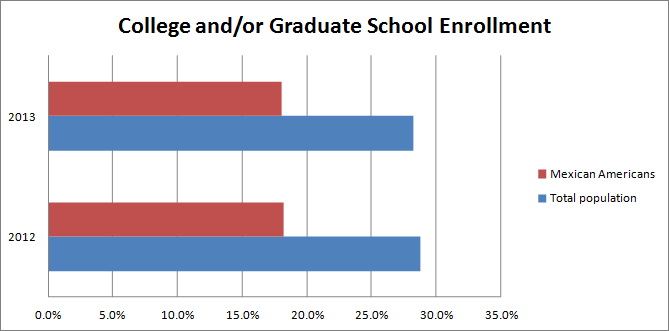
EDUCATIONAL ATTAINMENT
Educational attainment for the general population has risen by .3% from the years 2012 to 2013. For Mexican Americans, it has decreased by .1%
Earned bachelor’s degrees for the general population have risen by .2% and a bit more for Mexican Americans at .3%
Associate degrees and/or some college has shown little change across the board.
Unfortunately, only 2.8% of Mexican Americans and 1.5% of foreign-born Mexican Americans completed a graduate or professional degree in 2013. This is an extremely low percentage because the total population completion of a graduate or professional degree in 2013 was 11.2%. Why are Mexicans and native-born Mexicans not obtaining their graduate degrees? While only 7.3% of Mexican Americans have B.A. degrees, many are settling for associate degrees—21.8% of Mexican Americans and 12.1% of foreign-born Mexican Americans are ending their academic careers upon achieving these two-year degrees, according to the 2013 data.
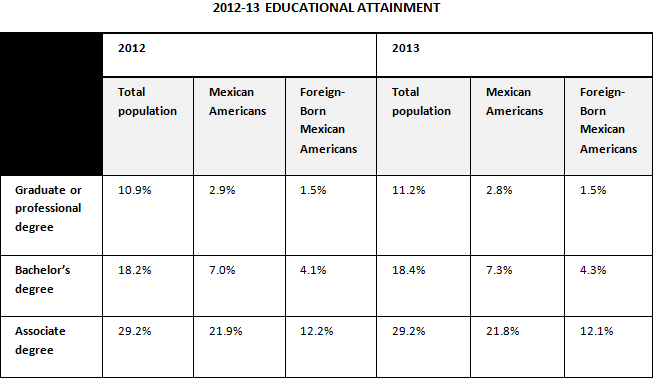

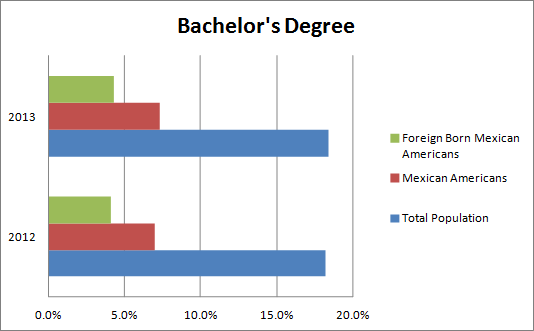
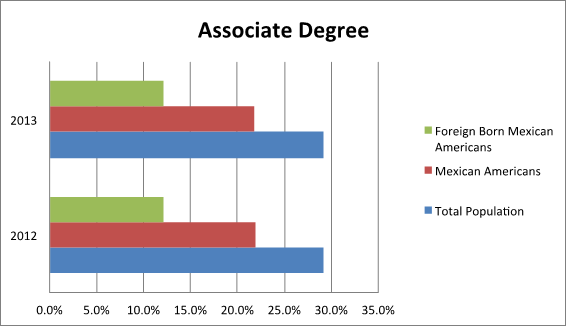
OCCUPATIONS
For the year 2013, the data for civilian employed population 16 years and over in management, business, science, and arts occupations is: 36.3% for the total population, 16.7% for Mexican Americans, and 9.2% for foreign-born Mexican Americans. Again, dismal figures.
Compared to the 2012 results, which were for the total population of 36.1% and for Mexican Americans 16.6%, there was a .2% increase for the total population and .1% for Mexican Americans. There was also a .2% increase for foreign-born Mexican Americans. Not much change, but some hope.
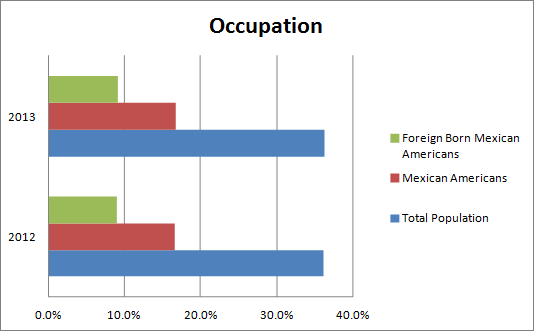
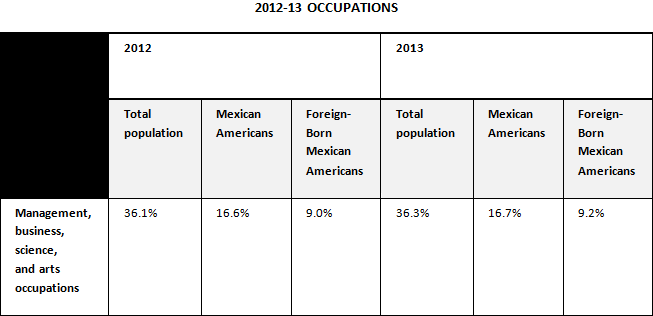
INDUSTRY
For professional, scientific, management and administration, and waste management services, 2013 employment for the total population was 11.1% and 10.2% for Mexican Americans, with foreign-born Mexican Americans at 11.5%. The 2012 results were for the total population 10.9% and 10.2% for Mexican Americans with the foreign-born Mexican Americans at 11.6%. No change for Mexican Americans and a .2% increase for the total population. However, a happy surprise: in 2013, foreign-born Mexican Americans topped all groups at 11.5% with a small decrease from 2012.
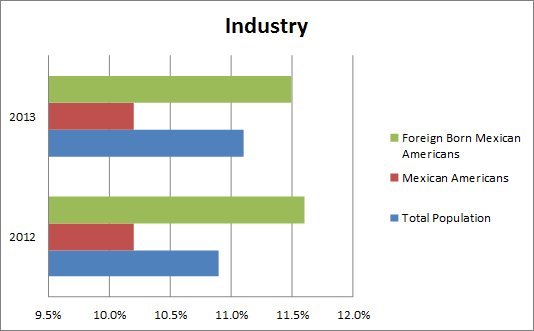
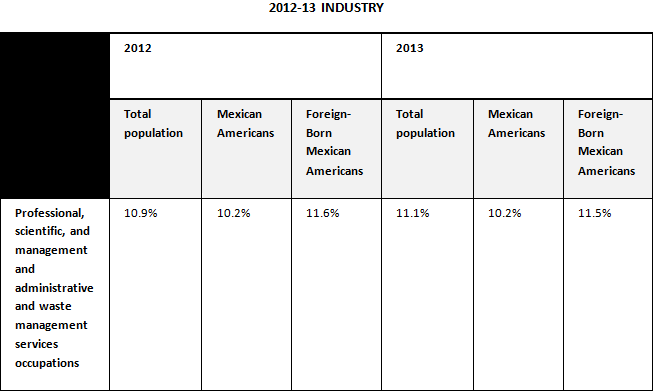
This represents a mixed picture for Mexican Americans and for foreign-born Mexican Americans in their quest for parity with the total population.
Solution for Retaining Minority Students in Higher Education
Scott Watson Swail’s 2003 report (1) on student retention programs in higher education states that a comprehensive student retention program should:
- rely on proven research
- suit the particular needs of the campus
- be institutionalized and become a regular part of campus service
- involve all campus departments and all campus personnel
- take into consideration the dynamics of the change process and provide extensive and appropriate retraining of staff
- be student centered
- operate in a cost-effective way, and not be tied to soft monies
- have the support of a comprehensive student monitoring system that will become the foundation of all institutional research on campus and support every department
- be sensitive to student needs and to diverse populations.
At least some of the above recommendations would go a long way to encourage many minority students to continue their higher education by obtaining a graduate or professional degree.
Berkley, Stanford, UCLA, and Caltech collaborate to boost minority Ph.D. students by recruiting underrepresented students in mathematical, physical and computer sciences, and in engineering.
UC Berkley put it best: “The four schools are creating a unique, cross-institutional community of underrepresented minority Ph.D. students, postdoctoral scholars, and faculty members in the targeted fields; developing faculty training to better recognize and help these students thrive and advance; and conducting research that includes annual surveys of Ph.D. students about what factors impact their attitudes, experiences and preparation for the future.”(2)
References
- Census Bureau, Selected Population Profile in the United States: 2012 and 2013
- United States S0201 and B 05006. Selected population Profile in the United States
- Population groups: Mexican and Mexico (foreign-born)
- Data set: American Community Survey 1-Year Estimates for years 2012 and 2013.
- Census Bureau, American Fact Finder, Selected population Profile in the Untied States.
————————————————–
(1) Watson Scott Swail, Retaining Minority Students in Higher Education: A Framework for Success, George Washington University, 2003
(2) Gretchen Kell, “Berkeley, Stanford, UCLA, Caltech unite to boost number of minority Ph.D. students, faculty,” UC Berkley News Center, February 13, 2014
Jupiter’s El Sol wins grant from Mexico to enhance education programs
The Mexican Consulate on Tuesday awarded the El Sol Neighborhood Resource Center a $9,000 educational grant known as IME Becas to support and enhance their adult education programs at the center at the southwest corner of Indiantown Road and Military Trail.The IME Becas program began in 2005 to raise the education levels of the Mexican population living in the United States.“We are thrilled to have been selected by the Mexican Consulate to further our education mission with this tremendous grant,” said Dora Valdivia, Associate Director of El Sol. “Our students become empowered by creating a solid foothold with their literacy, which allows them to aspire towards increased educational goals that becomes the gateway to opportunity.”…
Extraordinary Women in Texas: A Phenomenological Study of Mexican American Female Superintendents
SA Rodriguez – 2014
… from family and professional colleagues. These support mechanisms assisted them in coping
with cultural incongruence and school board affairs. The strategies and skills that the participants
depicted in this study will provide aspiring Mexican American female superintendents …
Link to dissertation
Majority of of STEM College Graduates Do Not Work in STEM
Jul 10, 2014 – About the Newsroom · Facts for Features · News Releases · Press Kits · Tip Sheets … The U.S. Census Bureau reported today that 74 percent of those who have … however these graduates are not necessarily employed in STEM occupations … The tables released today highlight statistics on field of degree, …
Link to press release
Mexican American Mobility: Early Life Processes and Adult Wealth Ownership
LA Keister, JA Vallejo, EP Borelli – Social Forces, 2014
… capital who encounter a positive context of reception will have children (the second generation)
who attain professional occupations and … Empirical tests of segmented assimilation compare young
adults from various immigrant groups and find that Mexican American youth face …
Link to abstract


